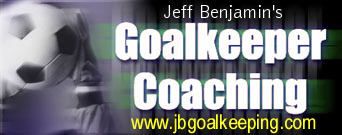
|
"Outstanding keeper instruction. This is a must for goalkeepers and coaches." —Ottawa Internationals S.C. web site, Ottawa, Canada |

|

|
Top |
Goalkeeping Tips, Tidbits and Random Thoughts
An athlete talking to themsleves during competition is hardly a new phenomenon.... The talk does not have to be vocal. By merely thinking you are talking to yourself and sending a message.
-- Tony DiCicco, Goalkeeper Soccer Training Manual
If you have a question, comment or rebuttal you'd like to see addressed here, send me email. I will post your mail to the blog at my discretion unless you specify otherwise.
Communication breakdown
Think you communicate well in goal? Try this exercise and see how you do:The goalkeeper stands behind two defenders. In front of the defenders are three attackers with a ball. The attackers move only at a walking pace, passing the ball back and forth. If an attacker is not pressured, they may walk forward with the ball until confronted. The goalkeeper must direct the defenders to defend the ball and keep the attackers from advancing.
Sound simple? There's a catch--the defenders may not move unless the goalkeeper tells them to, and then must do exactly as the keeper says.
It is not nearly so easy as it sounds. I have watched experienced players stammer, freeze up and storm off in frustration after trying this activity. It takes constant decision making and quick, concise communication to pull off well.
Even with the attackers at a walk, the keeper needs to have a constant stream of commands: "Joe, step to the ball!" "Pete, drop back a bit." "Joe, slide left." "Pete, pressure ball!" "Joe, stay in the middle."
Coaching points:
- Use a name for every command, so the defenders know who should do what.
- Use explicit directions (forward, backward, right, left, middle, etc.) so there's no question about where to go.
- Start at the ball and then work away. Pressure on the ball comes first, but don't forget to direct the cover and balance next.
- Make sure the goalkeeper and defenders have a common vocabulary. If the goalkeeper gives directions the defenders don't understand, everything falls apart.
Labels: Training
All Russians want to be goalkeepers
Jonathan Wilson at The Guardian tells us why all Russians want to be goalkeepers.Labels: Goalkeeping News and Analysis
The eyes have it
A study done of elite hockey goalies shows that one of the keys to performance is what researcher Joan Vickers at the University of Calgaryis dubbed "the quiet eye," the critical moment of focus prior to action: Key to Hockey Goalie Success Discovered."Elite goalies focused directly on the puck nearly a full second before the shot was released nearly three-quarters of the time," according to the research. I'm sure the same goes for goalkeepers in soccer. Keepers need to learn to "read" the shooter and predict when the shot is coming so they can be ready, have their head still, and be able to focus on the ball.
The mantra I use with my keepers is "Feet, eyes, hands." Before the shot is struck, get into the ready position (feet), focus on the ball (eyes), and then save with your hands.
Labels: Catching
Professional training clips
Thanks to Nathan over at KeeperZone for finding this page of vidclips of Jens Lehman and Timo Hildebrand training at Torwart.de. The thing to note is that there is nothing fancy here. Basic warm-up & stretching, catching volleys from the coach, diving technique, taking a series of balls from close range, and various simple handling exercises. Obviously there is more work going on when the keepers are back in with the team, but even—in fact, especially—at the professional level keepers need to focus on the basics.Labels: Training